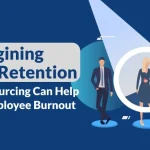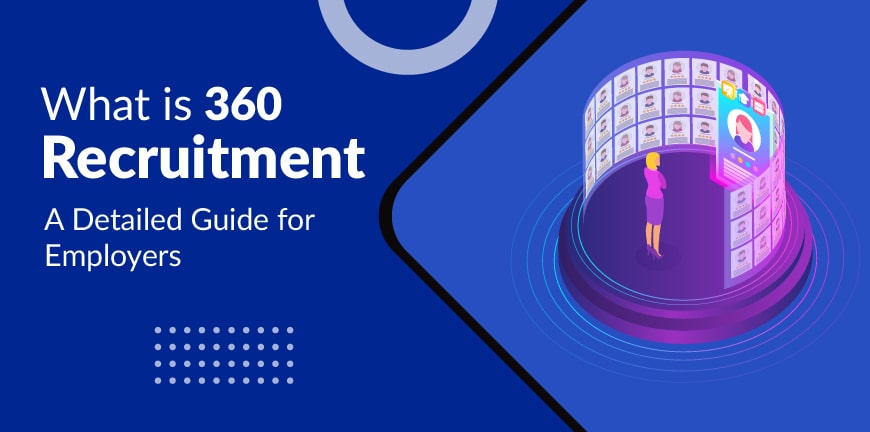
Project Staffing: What It Is, How It Works, and Benefits
16/07/2025
Reimagining Talent Retention: How Outsourcing Can Help Reduce Employee Burnout
16/07/2025- What is the Meaning of 360 Recruitment ?
- Who is a 360 Recruiter?
- What are the Strengths and Weaknesses of 360 Recruitment?
- What are the Disadvantages of 360 Recruitment?
- What is the Difference Between 360 and 180 Recruiting?
- What are the Key Stages in the 360 Recruitment Process?
- What are the Challenges of 360 Recruitment?
- How Does 360 Recruitment Compare to Other Models?
- Are You Looking Recruitment Partner?
- Frequently Asked Questions (FAQs)
In a world where the job market is constantly evolving, finding the perfect candidates for suitable job positions becomes a tall task. It is no longer just about positions that are required to be filled, but about a technique that is sustainable, embracing values, culture, and vision that are in sync.
A 360-recruitment model takes hiring to greater heights by catering to all facets from manpower mapping to searching for candidates, onboarding, and formulating retention designs. The holistic approach prepares a robust talent bank for organizations that not only caters to today’s needs but also readies them to take on future challenges.
What is the Meaning of 360 Recruitment ?
360 recruitments meaning can be well defined as a comprehensive hiring method that is managed by a single recruiter. The recruitment journey is maintained full cycle from the beginning to the end by the recruiter. 360 recruitment entails all aspects, including client management, candidate searching, assessing, interviewing, and onboarding.
Who is a 360 Recruiter?
A 360-degree recruiter oversees a 360-degree recruitment cycle. This individual or an agency control and handles the full recruitment procedure and is the link between businesses and candidates throughout the employment cycle.
What are the Strengths and Weaknesses of 360 Recruitment?
The efficient and organized 360-degree recruitment process has various advantages. Let us take a look:
1. Consistent and Reliable
One of the significant benefits of a 360-recruitment cycle is that the onus is on a dedicated recruiter who is responsible for the end-to-end cycle, instead of distributing tasks to various professionals, enabling them to understand the demands of both client and candidate thoroughly. This establishes a consistent system of communication, planning, and accountability.
2. Improved Candidate Experience
The relationship between a candidate and client is enhanced as there is just one point of contact in a 360 recruitment cycle. Candidates must communicate with one recruiter throughout the process, driving a consistent structure that fosters a sense of trust and continuity, leading to expected outcomes and fulfilling experiences.
3. Extensive Market Knowledge
Recruiters in a 360 model not just help in managing the recruitment cycle, but they also act as advisors. They are constantly updating themselves with the new and trending industry developments.
They offer deep insights about salary standards, new skills in the market, competitor status, etc. They can guide candidates accordingly, and for clients, it is useful as they can take smart and informed steps in less time and craft meaningful manpower plans.
4. Cost-Effective Recruitment
The 360 recruitment is a consolidated procedure taken care of by a single recruiter, and companies can cut down on their overhead expenses by avoiding hiring multiple agencies or recruitment professionals.
This helps organizations to reduce costs related to screening, onboarding, etc. Additionally, a one-man ship diminishes delegation of responsibilities, driving a faster process with accelerated productivity.
5. Enhanced Retention Rates
This approach ensures that the recruiter is an intrinsic part of all the hiring phases. So, from the start, when candidates are acquired, recruiters develop a rapport with candidates, understanding their demands and mindset.
They are also well-versed in the company values and work culture, creating a bridge between clients and candidates, building trust and compatibility. This results in finding top-notch matches and premium quality hires, and higher retention rates as candidates are continuously engaged.
What are the Disadvantages of 360 Recruitment?
Here are a few weaknesses of 360 recruitment:
1. Time Scheduling Issues
Full-time recruitment cycles can be time-consuming as a singular recruiter deals with all stages of recruitment, resulting in delays in processes. The method can also alleviate the hiring duration hindering processes, and at times, exhaustion for recruiters.
2. Multiple Skill Requirement
Recruiters hired for this model have to be multitaskers possessing a wide skill range that might be difficult to find. The recruiter will handle an array of recruitment stages and require niche skills to excel in all aspects. The management of the phases significantly impacts service quality.
3. Inapt for Big Firms
The full cycle model is suitable for smaller enterprises or specific roles, but it becomes a hazard if there is high demand or meeting the demands of larger organizations, as it becomes a tough nut to crack for a sole recruiter. Managing multiple tasks at the same time becomes a problem, leading to inconsistent and poor outcomes.
4. Risk of Unintentional Partiality
Since a single individual handles the entire process from searching to selection, there might be an unconscious sense of bias that might impact important decisions. Unlike recruitment models that have various layers of recruitment teams bringing in new perspectives and ideas, the 360-recruitment model ingrains most of the power in one person, making it their responsibility to use it efficiently.
What is the Difference Between 360 and 180 Recruiting?
180 recruiting is a method that essentially focuses on fishing for candidates and delivering them to clients. It is a recruitment model that manages a particular phase of recruitment. The 180 recruiters gain intense expertise in various sectors and their trends or roles, making it easy for them to spot top-quality candidates. They are focused on candidate satisfaction and their welfare.
Meanwhile, a 360 recruitment strategy handles the recruitment process in totality, taking on responsibilities for the myriad stages. The system entails finding candidates to recruiting and onboarding them.
It is a full-cycle recruitment procedure and requires recruiters to have a wider skill set to manage all areas of hiring. This process provides recruiters with complete control of the process, building firmer relations with both client and candidate, and initiates a slick, centralized management framework.
What are the Key Stages in the 360 Recruitment Process?
The important stages of the 360 recruitment process are as follows:
1. Deciphering the Recruitment Needs
The primary phase involves recruiters thoroughly understanding the overall requirements of an organization and the demands of specific job positions.
2. Job Description Design
After comprehending the organization’s needs and job roles, the recruiter focuses on crafting compelling job descriptions.
3. Obtaining Candidates
This is an extensive process of searching for suitable professionals who cater to the requirements of companies.
4. Assessment and Filtering
Recruiters start the evaluation process after finding appropriate candidates by reviewing their profiles and initiating assessment tests, finally shortlisting the best of the lot.
5. Interview Stage
This involves recruiters conducting rigorous interviews and selecting the final candidates who fit the cultural, skills, and experience brackets.
6. Selection and Propositions
After the evaluation phase, the recruiter moves forward with selecting the candidate and initiates the job offer process that includes negotiations, and they efficiently become the communication medium between the client and the selected candidate.
7. Onboarding and Transition
The recruiter is responsible for the smooth integration of a new employee into the ecosystem of an organization, supporting and guiding them with the necessary tools.
What are the Challenges of 360 Recruitment?
Here are a few common challenges of 360 recruitment:
- Classic Burnout issue- Recruiters might get tired and lose focus as they are burdened with too many tasks at the same time. They might find it difficult to balance every job simultaneously.
- Mismatch of Skills- A 360 recruiter is expected to have a vast set of skills, knowledge, and talent so that they can deal with critical areas of a recruitment procedure. Sometimes they might not master the skills that does not match their natural talent, leading to underperformance.
- Technological Dilemma- Some 360 recruiters and recruitment agencies struggle to incorporate modern technologies and solutions that can back the 360 model.
- Unreasonable Expectations – Organizations sometimes impose unrealistic expectations on recruiters related to deadlines and, quality of candidates required. Recruiters find it hard to present candidates with remarkable talent due to limited time per candidate.
How Does 360 Recruitment Compare to Other Models?
A recruitment model becomes ideal once it complies with an organization’s exclusive requirements, scale, and available supplies. 360 recruitment meaning is justified when we understand that it is a method that is essentially impactful for businesses that have a smaller size or niche roles, and a one-point contact system offers the required consistency along with accelerated candidate engagement.
Meanwhile, models like 180 or others may be a better match for bigger enterprises that facilitate substantial recruitment, where fast movement and expertise are vital. Furthermore, the heightened focus on skills-oriented analysis and technological integration in recruitment is enabling companies to rethink the process of identifying and evaluating skills, fostering an innovative and adjustable hiring environment.
Are You Looking Recruitment Partner?
Are you at the crossroads of wanting to hire new employees, but unable to juggle the requirements in this competitive landscape? Connect with us at Alp Consulting, our team of seasoned experts can empower you to establish a future-prepared force.
We can be your guide and support system if you are a start-up and looking at expanding your operations, or a large enterprise seeking a full-cycle recruitment model. We are here to make a difference. We redefine the 360 recruitment meaning by introducing effective solutions and innovation. Let us help you align your business objectives with recruiting top-notch hires and create meaningful and strong teams.
Frequently Asked Questions (FAQs)
1. What is 360 recruiting?
360 recruiting is a method in which a sole recruiter takes the full responsibility of managing and monitoring a comprehensive hiring process from start to end.
2. What is 180 recruitment?
180 recruitment essentially emphasizes a specific stage of recruitment, mainly candidate sourcing and screening, unlike the 360-recruitment process.
3. What is the 360-degree approach in talent acquisition?
A 360-degree approach in talent acquisition refers to a full cycle or end-to-end recruitment where a single recruiter handles all stages of recruitment.
4. Is full desk recruiting the same as 360 recruiting?
Full desk recruiting and 360 recruiting are similar models where a single recruiter manages the entire recruitment cycle.
5. What is the 360 recruitment model?
A 360 recruitment model or full cycle recruitment method is an approach in which the entire recruitment procedure I managed by a single recruiter or recruiting team.
Contact Us For Business Enquiry

Amit Saproo
Amit Saproo is the Head of Operations at ALP Consulting with nearly 17 years of experience in Executive Search, RPO, Leadership, and IT & Engineering recruitment. He leads nationwide recruitment programs across Technology, BFSI, and R&D domains, driving strategic hiring solutions for diverse client needs. Amit excels in building and managing high-performance teams that deliver scalable, end-to-end recruitment and consulting services.




